Best Conferencing Microphones for 2020
What you need to know to find the best microphone for your conference room setup.
Nothing is worse than wasting precious moments of your meeting time getting your conference room technology to work, especially when you have to wait for the IT manager to show up to work out the issues. Conference room tech may not be made to dazzle, but if it’s good, your attendees will take notice—even if the technology is designed for them not to.
If you haven’t evaluated your conferencing microphone solution recently, you’re almost certainly not getting the best sound possible out of these vital meeting spaces.
Due in part to the ongoing COVID-19 pandemic, recent months have seen a flurry of innovations in conferencing mic technology from well known innovators like Bose and Sennheiser, including new pickup technologies and comprehensive sound control that make sure your meeting focus stays where it should.
Benefits of Conferencing Microphones
With adjustable lobes and audio tracking technology, new systems can adjust automatically to whoever is speaking at any given time, giving meeting attendees the ability to freely inhabit a space and making audio dead spots a thing of the past. Technology providers are not only putting their focus into the physical microphone but retargeting their product portfolios into all-in-one conferencing solutions, ensuring your audio quality and technology capabilities are exactly where you need them to be.
Seamless integration is the name of the game when it comes to recent advances in conferencing microphone design. Gone are the days when meeting attendees would need to crowd around a single microphone just to be heard. Now, microphones can be placed on the ceiling or the walls, or even built into the table itself to complement your overall conference room aesthetic.
Ceiling-Mounted Conferencing Microphones
Ceiling-mounted microphones are camouflaged in the conference room by the fact that meeting attendees rarely look up. Besides fostering a clean look, they eliminate cable clutter on the table.
Ceiling microphones may be installed flush to the ceiling or may hang down in a pendant style. Audio-Technica’s ES954 Hanging Ceiling Microphone Array, for example, may be used singly or in multiples to capture every person speaking in a room, with the total number of channels restricted only by the capacity of the mixer or DSP device controlling the system.
A daily selection of features, industry news, and analysis for AV/IT professionals. Sign up below.
Related: Conferencing Survey Highlights Importance of Good Audio
Biamp’s Parlé microphones come in pendant (hanging), tabletop and ceiling configurations. The Parlé TCM-XA is an AVB low-profile ceiling microphone and PoE+ amplifier for use in Biamp’s Tesira systems. Each microphone includes Beamtracking technology with four 90-degree zones, providing full 360-degree coverage of the meeting space. The pendant version, called Parlé TCM-1 Pendant, includes Beamtracking and three 120-degree zones, providing 360-degree coverage of the space.
AVB in the Parlé microphone description stands for Audio Video Bridging, an open networking protocol for AV applications such as microphones and loudspeakers. AVB and Dante are very common enabling technologies for digital audio networks, but Dante is a proprietary technology developed by Audinate.
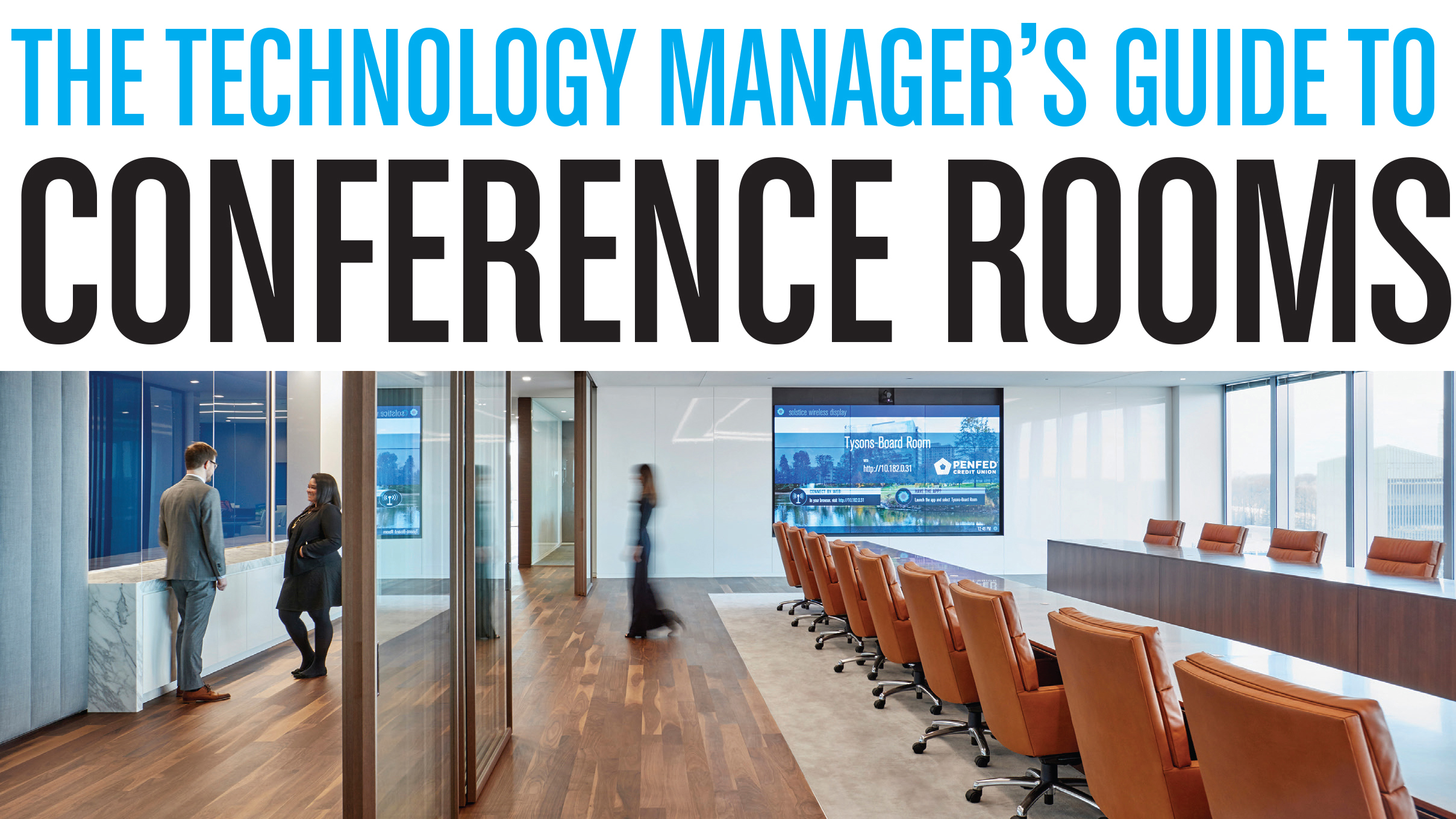
The Technology Manager's Guide to Conference Rooms addresses today's shift to IT-centric platforms. Download it now.
Another feature to look for in a conferencing microphone is Power over Ethernet (PoE), which makes integration of the ceiling mic very easy. PoE is a standard for delivering power to devices over Ethernet cable instead of requiring a separate power supply and outlet.
The kind of ceiling in the room is a factor to consider in choosing your conferencing mic. The Audix M3WHM tri-element installed sound ceiling microphone is constructed for hard mount ceiling installations without drop tile ceilings, while Vaddio’s CeilingMIC microphone’s design allows for custom ceiling drop cable length to support drop tile ceilings and open ceiling environments.
Related: Acoustics and the Modern Meeting Room
ClearOne’s Beamforming Microphone Array 2 features beamforming and adaptive steering technology which automatically keeps the beams focused on the speaker, no matter where they are. As well, it offers acoustic echo cancellation and noise cancellations for crystal-clear audio.
Shure’s MXA910 Ceiling Array Microphone with IntelliMix is a solid solution that aids transparent meeting intelligibility. Participants are often oblivious to its presence in a meeting, meaning they are clearer and more natural when speaking. The eight steerable lobes provide tight, directional audio pickup.
Most technology providers offer a variety of sizes and models to ensure they offer a solution appropriate for every size and type of meeting space. The Beamforming option from ClearOne, for example, includes three mounting options—ceiling, wall and table—to suit most meeting room applications.
Sennheiser’s TeamConnect Ceiling 2 also offers beamforming technology to focus on the speaker and adapt to the acoustic condition of the room. Like many conferencing microphone products being developed today, it features support for Dante digital network connections, as well as analog options. Sennheiser’s TeamConnect Ceiling 2 may be flush-mounted into standard false ceilings, suspended above the conference room table if the ceiling is very high, or mounted directly on the ceiling.
Features to Look For
Beyond the flexibility that allows speakers to move freely around a meeting space, organizations are looking for user-friendly systems that are easy to install and require limited technical assistance. Many new products on the market also allow IT managers to remotely manage the system, allowing them to assist with multiple meetings taking place simultaneously throughout the company.
Related: Sound Reinforcement Remedies
Organizations are also looking for intuitive systems that automatically locate excess noise and echoes and balance them out in the broadcast. This process also helps to balance sound quality between the presenter and audience, ensuring that any side conversations don’t distract from the overall presentation.
With many teams separated throughout the country because of COVID-19 restrictions, meeting platforms like Zoom, GotoMeeting, and Microsoft Teams are being used more than ever. Conferencing audio systems are built to accommodate these platforms, keeping teams connected no matter their location and making sure the remote experience is just as good as the one in the room.
Can You Manage and Install Conferencing Mics Yourself?
If you have a limited IT team, there is no need to fret with conferencing mics. Ease of use is often at the forefront of the development process. These systems often offer guided prompts or have limited the number of steps, thereby simplifying installation. Many have also looked for ways to streamline the process, including limiting the number of cables required for connection.
With many systems using automatic updates and audio tracking, only minimal interaction is necessary between the user and the system for everything to work seamlessly. The key for most technology providers is developing something so intuitive that the user couldn’t possibly have concerns or issues. If they do, it’s easy to have an IT manager control the system remotely, limiting the amount of time they need to go room to room addressing constant tech issues.
Related: Hot Mics – The Latest in Conferencing Audio Capture
Conferencing Mics at a Glance
1. Shure MicroFlex Advance Array Microphones
Best "not aware it's there" microphone solution
Looking for technology that will blend seamlessly into your environment and make you forget you installed it? Shure Microflex Advance Array Microphones may be the option for you—the company says it pairs innovative design with superior capabilities and allows you to not compromise aesthetics for audio.

With ceiling, linear, and table options available for integration, these microphones use Steerable Coverage for dynamic audio capturing and pairs with Shure’s Designer System Configuration Software and SystemOn Audio Asset Management Software, allowing your team to focus on the presentation on hand and not the technology. The MXA910 Ceiling Array Microphone with IntelliMix has up to eight adjustable lobes that use Autofocus Technology to adjust the positioning of the lobes in real time, allowing users to freely move within the space and not worry about issues with audio capture.
The MXA910 also features numerous mounting options to make sure that any ceiling type, including hard ceiling, VESA pole mount, or wire rope suspension, does not hold you back from integrating this superior technology.
Related: New Microphone and App Designs Connect Attendees at Conferences and Events
2. Sennheiser TeamConnect Ceiling 2
Best option for flexibility
The Sennheiser TeamConnect Ceiling 2 integrates patented automatic dynamic beamforming technology to help adapt to any meeting room environment without having to reconfigure the entire system. This technology not only allows for flexible usage within the space but easy collaboration with remote participants as well.
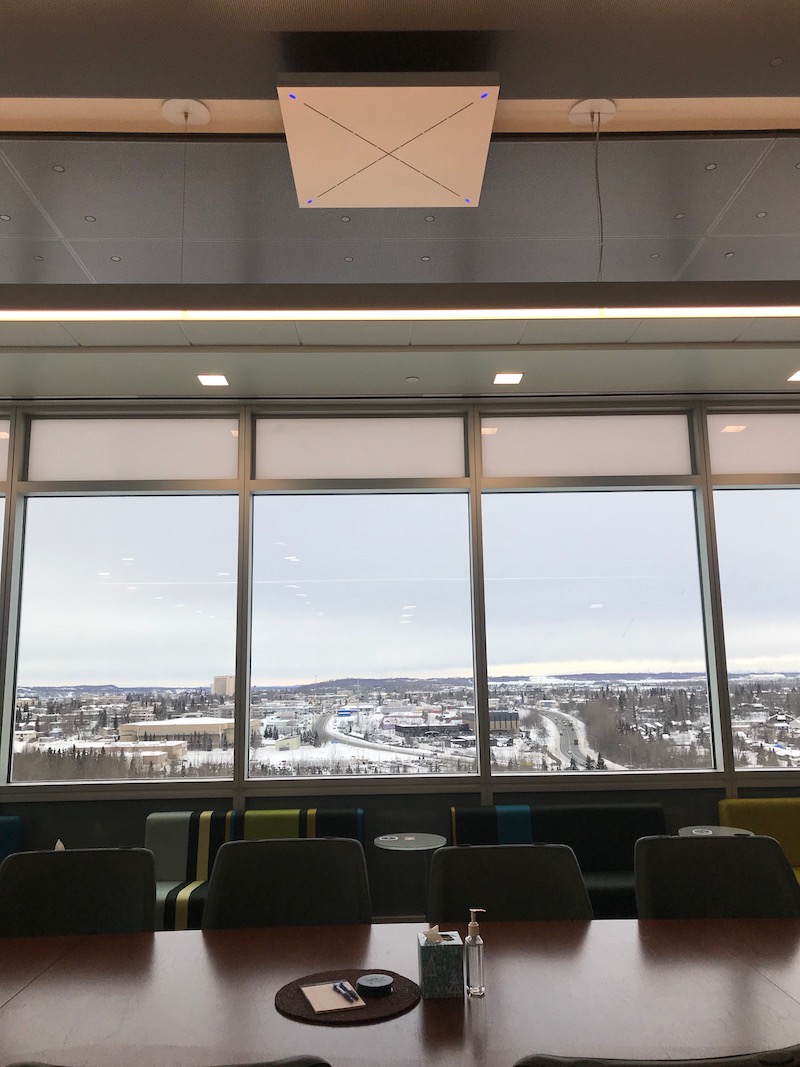
Using Sennheiser Control Cockpit software, users have the ability to monitor and control the microphone through a web interface that can be accessed through any device within the network. This allows IT managers the freedom to deal with any issues or help control meetings remotely. The microphone can also be connected via analog or digital Dante audio outputs for usage within any conference system. The system can also be used by outside presenters, allowing them to present hands-free and focus on engagement with their audience.
The system offers three installation variants, including flush-mounted, suspended, and ceiling-mounted, allowing for a variety of options for every type of meeting space. Power-over-Ethernet (PoE) allows for easy integration and open media control protocol (API) makes it easy for your team to make individualized adjustments whenever needed.
3. Yamaha Adecia Enterprise Audio System
Best for ease of installation and configuration
The Yamaha Adecia Enterprise Audio System is a great option for those organizations looking for a comprehensive package that provides intuitive technologies that overcome major challenges surrounding integration and room acoustics, allowing for reduced setup time, costs, and other integration-based challenges. The system automatically detects new components and configures new devices, limiting the number of hours your tech support team will need to devote maintaining and updating the device.
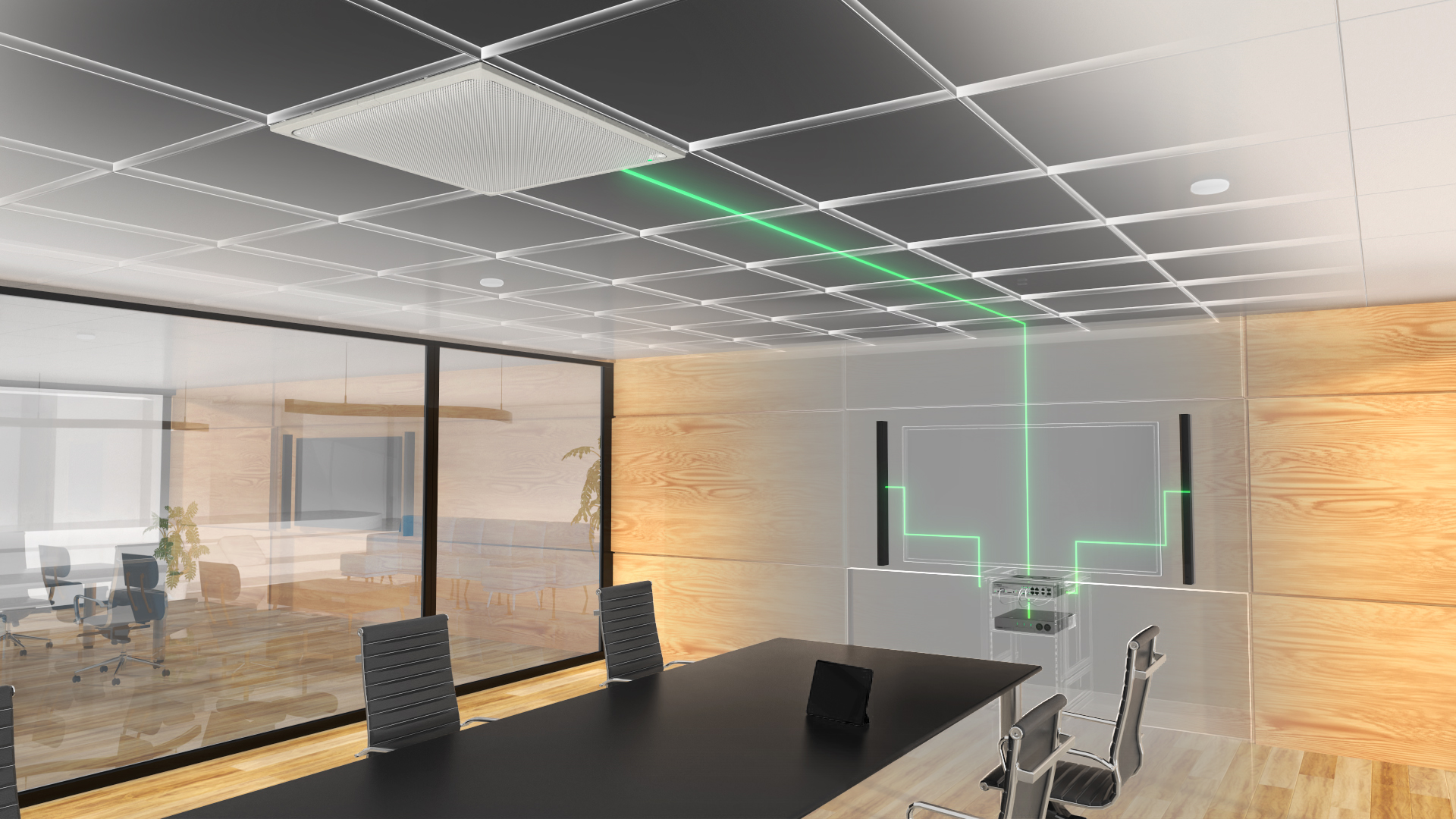
It also auto-optimizes audio performance, picking-up reverberation and echoes to ensure clear audio sound quality. Multi-beam tracking technology ensures that your team can still enjoy vibrant conversations with multiple participants without having to worry about your lobe settings. With no fixed lobes, the conference space can be rearranged to a variety of configurations without worrying that dead spots will be created in the new setup. Organizations will also be able to install and set-up on their own using a three-step guided configuration process. Due to the multi-beam tracking, there is no need for preprogramming lobes and all of the components utilize a one network cable connection, limiting the confusion created by multiple wire configurations. With open API capabilities, the system can easily integrate with other Yamaha or third-party products.
4. Bose ES1 Ceiling Audio Solution
Best integrated solution
Combining the performance of the Bose Edge Max in-ceiling loudspeaker and the Sennheiser TeamConnect Ceiling 2 microphone, the Bose ES1 Ceiling Audio System is a premium solution for fully integrated meeting rooms. The system also uses a Bose amplifier and DSP to provide your team with a seamless experience that allows for a quick and easy deployment in a variety of different spaces.
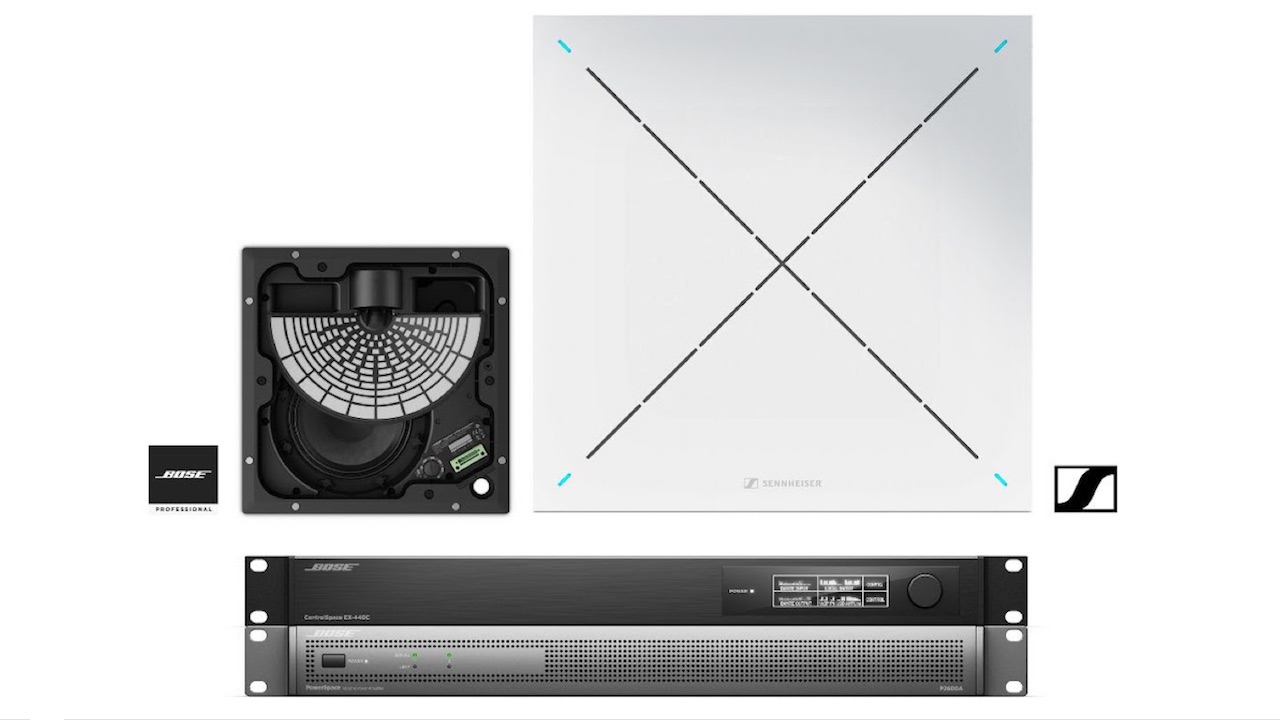
With fewer devices on walls or tabletops and echo-cancelling technology, users have the freedom to spread out throughout the room without worrying about not being able to be heard or the ability to participate fully in the meeting, allowing teams to focus on working together to move projects forward and focus on creating the next big idea for your company.
The system also has the ability to integrate popular unified communications platforms, including Microsoft Teams, Zoom, and Google Hangouts Meet, to make sure any meeting type can be streamed through the system. Through the combination of globally respected brands that you know and trust with reference configurations reducing the overall installation time, organizations can trust that this solution will be one they can rely on for years to come, according to the company.
5. Nureva Microphone Mist
Best full-room coverage
Helping remote meeting attendees feel like they’re in the room where it happens, Nureva Microphone Mist technology utilizes virtual microphones to be able to improve sound pick-up in a variety of settings, allowing participants to stay distanced and not worry about overall sound quality. When two or more physical microphones work together on targeting sound in a particular zone, this creates a virtual microphone or individual pickup point.

Nureva Microphone Mist technology, which holds four patents, listens in on the full network of virtual microphones and optimizes them individually to create a seamless listening experience. The system has the ability for active zone control which allows the user to define a particular pickup zone and balance the audio between the presenter and audience. Intelligent sound targeting also identifies unwanted background noise and eliminates it from being picked-up during the meeting.
The system has the ability grow with your company and is available in three different models: HDL 200 (small spaces), HDL 300 (mid-size spaces), and Dual HDL300 (large spaces). Continuous firmware updates and easy DIY installation allow for IT managers to streamline everything internally within no ongoing tech support inquiries and visits.
6. Audix Dante AES67 Integrated Microphone System
Best plug-and-play integration
Audix’s Dante AES67 Integrated Microphone System includes a Dante AES67 interface (two- or four-input), as well as a choice of flush-mount (M70WD) or hanging (M55WD, M3W, M3G) ceiling microphones, or a combination of the two.
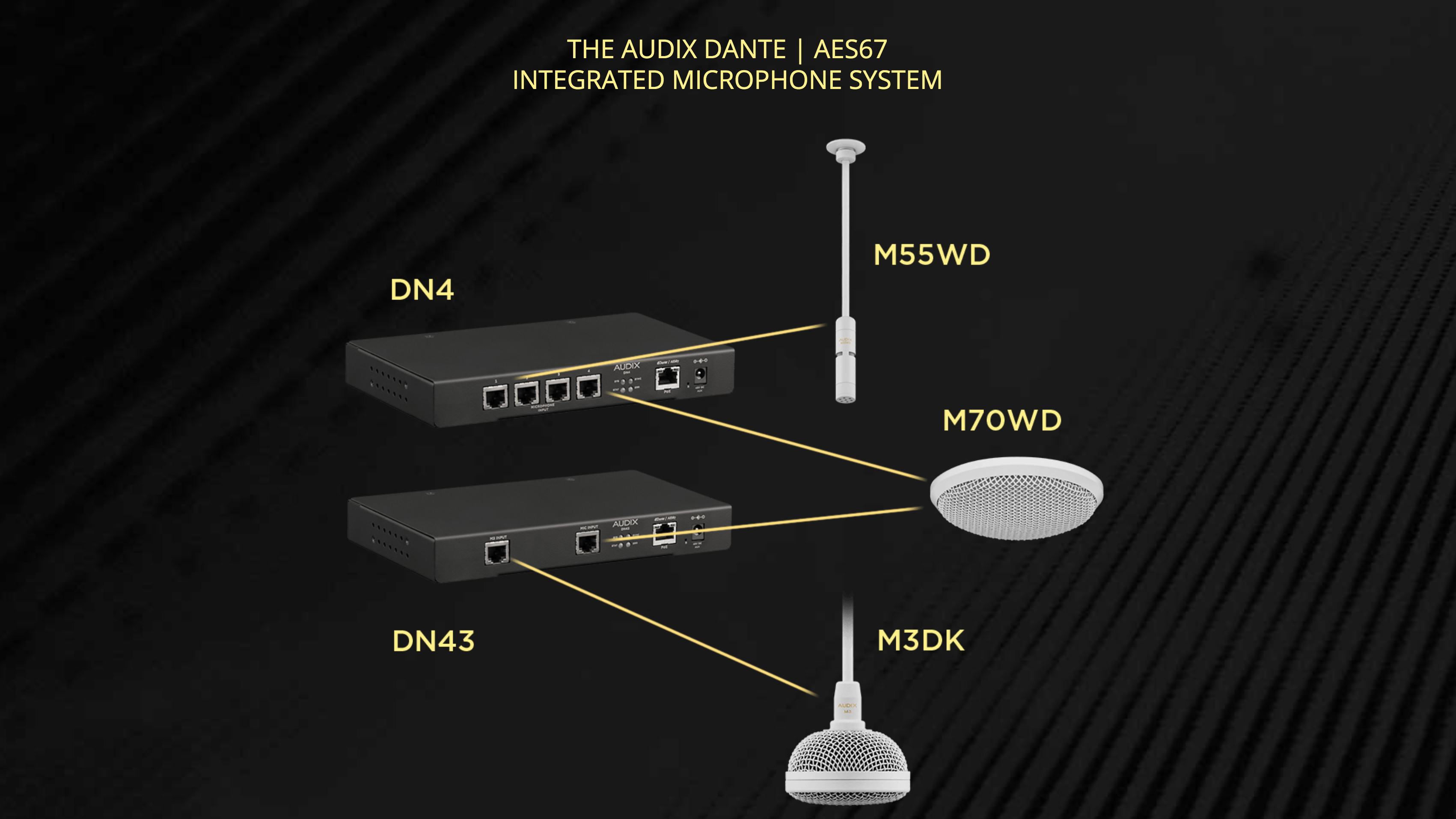
Either interface (DN4 and DN43) acts as the centerpiece of a microphone system that transmits over Ethernet networks. The interface provides microphone functions including on-off contact closure and LED status indicators for meeting rooms, convention centers, educational facilities, and houses of worship through a single Cat 5/7 cable with RJ45 connections at both interface and microphone. This simple configuration eliminates wiring errors, accelerates installation, and reduces cost. And the gain structures of all Audix RJ45-equipped analog microphones are optimized for their intended placement, providing quality audio at the DSP.
The two-input DN43 interface features one port for the Audix M3W or M3G tri-element microphone and one port for Audix RJ45-equipped single-element microphones. The four-input DN4 interface features four ports for Audix RJ45-equipped single-element microphones.
Jennifer is a freelance writer and marketing consultant based in the New York City area. Within the AV industry, Jennifer loves to explore how technology can alter the world around us, creating immersive experiences unlike any other. She has years of experience working with AV integrators, manufacturers, and event production companies in developing engaging content to increase their overall awareness.

